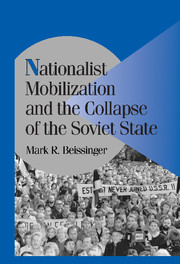Book contents
- Frontmatter
- Contents
- Illustrations
- Tables
- Acknowledgments
- 1 FROM THE IMPOSSIBLE TO THE INEVITABLE
- 2 THE TIDE OF NATIONALISM AND THE MOBILIZATIONAL CYCLE
- 3 STRUCTURING NATIONALISM
- 4 “THICKENED” HISTORY AND THE MOBILIZATION OF IDENTITY
- 5 TIDES AND THE FAILURE OF NATIONALIST MOBILIZATION
- 6 VIOLENCE AND TIDES OF NATIONALISM
- 7 THE TRANSCENDENCE OF REGIMES OF REPRESSION
- 8 RUSSIAN MOBILIZATION AND THE ACCUMULATING “INEVITABILITY” OF SOVIET COLLAPSE
- 9 CONCLUSION: NATIONHOOD AND EVENT
- Appendix I PROCEDURES FOR APPLYING EVENT ANALYSIS TO THE STUDY OF SOVIET PROTEST IN THE GLASNOST' ERA
- Appendix II SOURCES FOR THE COMPILATION OF EVENT DATA IN A REVOLUTIONARY CONTEXT
- Index
- Titles in the series
Appendix I - PROCEDURES FOR APPLYING EVENT ANALYSIS TO THE STUDY OF SOVIET PROTEST IN THE GLASNOST' ERA
Published online by Cambridge University Press: 18 November 2009
- Frontmatter
- Contents
- Illustrations
- Tables
- Acknowledgments
- 1 FROM THE IMPOSSIBLE TO THE INEVITABLE
- 2 THE TIDE OF NATIONALISM AND THE MOBILIZATIONAL CYCLE
- 3 STRUCTURING NATIONALISM
- 4 “THICKENED” HISTORY AND THE MOBILIZATION OF IDENTITY
- 5 TIDES AND THE FAILURE OF NATIONALIST MOBILIZATION
- 6 VIOLENCE AND TIDES OF NATIONALISM
- 7 THE TRANSCENDENCE OF REGIMES OF REPRESSION
- 8 RUSSIAN MOBILIZATION AND THE ACCUMULATING “INEVITABILITY” OF SOVIET COLLAPSE
- 9 CONCLUSION: NATIONHOOD AND EVENT
- Appendix I PROCEDURES FOR APPLYING EVENT ANALYSIS TO THE STUDY OF SOVIET PROTEST IN THE GLASNOST' ERA
- Appendix II SOURCES FOR THE COMPILATION OF EVENT DATA IN A REVOLUTIONARY CONTEXT
- Index
- Titles in the series
Summary
Event analysis is a method of tracking systematically over time the rise and fall of particular types of occurrences and the features associated with them. It first emerged in the social sciences in the 1960s as part of the behavioral revolution and was primarily used for cross-national studies of collective violence, wars, and military coups. Charles Tilly's work marked a turning point in applications of the method to the study of collective action, refocusing it toward analysis of temporal trends and linkages and purging it of some of the narrow behavioralist orientation that characterized early applications.
In addition to allowing systematic analysis of temporality in social and political relationships, one of the chief advantages of event analysis is its great flexibility. Events can be segmented by their particular characteristics. They can be aggregated at almost any meaningful level of space or time. It is a misnomer to speak of a single methodology of event analysis. Although certain common practices have emerged to ensure methodological rigor, the method has been operationalized differently in practically every application. Standardization of categories, definitions, and approaches across objects of analysis has remained elusive. Even the events that scholars have taken as objects of study have varied widely. Researchers must ultimately make decisions about which forms of action deserve to be analyzed, what features of those actions are worthy of attention, what sources should be used to gain information about these events, and how one should organize the process of recording information.
- Type
- Chapter
- Information
- Nationalist Mobilization and the Collapse of the Soviet State , pp. 460 - 471Publisher: Cambridge University PressPrint publication year: 2002
- 1
- Cited by



